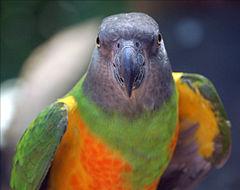Care of the Senegal Parrot
Pet Parrots
The Senegal
The Senegal parrot is one parrot variety that is appropriate for life in an apartment. The Senegal is colourful and charming. Even better as regards having neighbours close by, they are not too noisy. Most will imitate words they hear often and acquire quite a vocabulary over time. They are not too big, but are entertaining and sociable.

The Senegal has a high-pitched whistle and does squawk although he is not as noisy as some parrot species. There are three subspecies with the major difference being colour. They are similar in size and behaviour. The scientific name is Poicephalus senegalus.

Senegal Parrots (The Birdkeepers' Guides)
Amazon Price: $12.95 $6.96 Buy Now
(price as of Jun 15, 2013) Concise but complete coverage of
all aspects of keeping Senegal parrots
makes this a useful resource.
The Senegal (or Sennie) can be a delightful pet, quiet and friendly. Sometimes, though, they can be one-person pets, over-bonding with one member and becoming aggressive to others. Unfortunately this aggression may extend (because of jealousy) to their favourite handler as well. Some Senegals also have a tendency to bite when excited or in protest at some action that they disapprove of such as being returned to their cage. Young birds should be exposed to as many different situations and people as possible to minimise any likelihood of anti-social behaviour. Socialisation is extremely important for this breed and the best pets will be those that have been reared by hand from babies. If captured in the wild, the Senegal rarely becomes truly tame.

Super Bird Creations 12 by 5-Inch Crunch and Munch Bird Toy, Medium
Amazon Price: $11.97 $5.05 Buy Now
(price as of Jun 15, 2013) These toys satisfy a bird's need to
chew. By hiding treats in the vine
balls, your bird will be able to keep
himself occupied and stimulated.
Variety is the spice of life and Senegals should be given a varied diet. Dry food can be supplemented with raw or cooked vegetables. Most dry seeds will be eaten with relish. Sunflower, millet, soy bean, chick peas, split peas, mung beans, hemp are some that can be offered. Small amounts of apple and pear, lean chicken, cat or dog biscuits and boiled egg are other possibilities. If using a vitamin/mineral supplement, be sure not to give too much. Fresh, clean water needs to be available at all times.
All birds do best if allowed to stretch his wings and fly and if your Senegal doesn't have an outdoor aviary, he will need the opportunity to play and exercise outside his cage. An indoor cage needs to be at least 4 ft x 3 ft x 3 ft. In warmer areas, an outdoor aviary of 6 ft x 6 ft x 3ft should be provided. Hardwood perches will help keep his claws short.

Although the Senegal breeds reasonably easily in captivity, some will not do so until 6 or 7 years old. Breeders all have their individual preferences for the shape and configuration of breeding boxes. A box of about 8" x 10" x 18" should be suitable. They need a hole to allow entry and exit. This needs to have a diameter of 2 inches. A side door will allow you to inspect the nest. If you have no luck breeding your Senegals, try a different shaped nest.
Senegals will need some toys and something to chew on. Such items as swings and ladders will satisfy their need to climb and wooden items will help keep their beak trimmed nicely. To keep him friendly and tame, handle him each day. Try to keep to a routine and your Senegal will reward your trouble with hours of pleasure.
- Favorite Pet Birds: World's Most Sougth Parrot Species
Favorite Pet Birds: World's Most Sought Parrot Species Are you a bird lover? Do you have a pet bird? Well, one of the most popular species of birds as pet is the parrot. Parrots are among of the most favorite pet animals in the world not only...
- The World’s Most Intelligent And Brightly Colored Pet Birds
The World’s Most Intelligent and Brightly Colored Pet Birds This list of birds are not only among the most intelligent birds but also they are some of the most beautiful and colorful birds. Based or researches and studies with captive birds we have...
- The Starling: Bird Babbler That Makes The Best Pet Ever
If you are looking for a quiet pet bird, European starlings are definitely not for you. However, if you are looking for an energetic, sociable, vocal bird, they might be the best pick. Let's talk about the pros and cons of choosing a starling for...
- Exotic Pets: Degus
Exotic pets often draw a lot of attention and more and more people are looking for the perfect exotic pet. Not all exotic pets make good pets and not all of them are for everyone, but that doesn't always stop people from wanting one. The Degu is one...
- How To Teach A Parrot To Talk
Spanning across many different species and genera, parrots are among some of the most intelligent creatures on the planet. While not all parrots can talk, the one's that do talk have become justifiably loved by families who hope to take in a creature...
